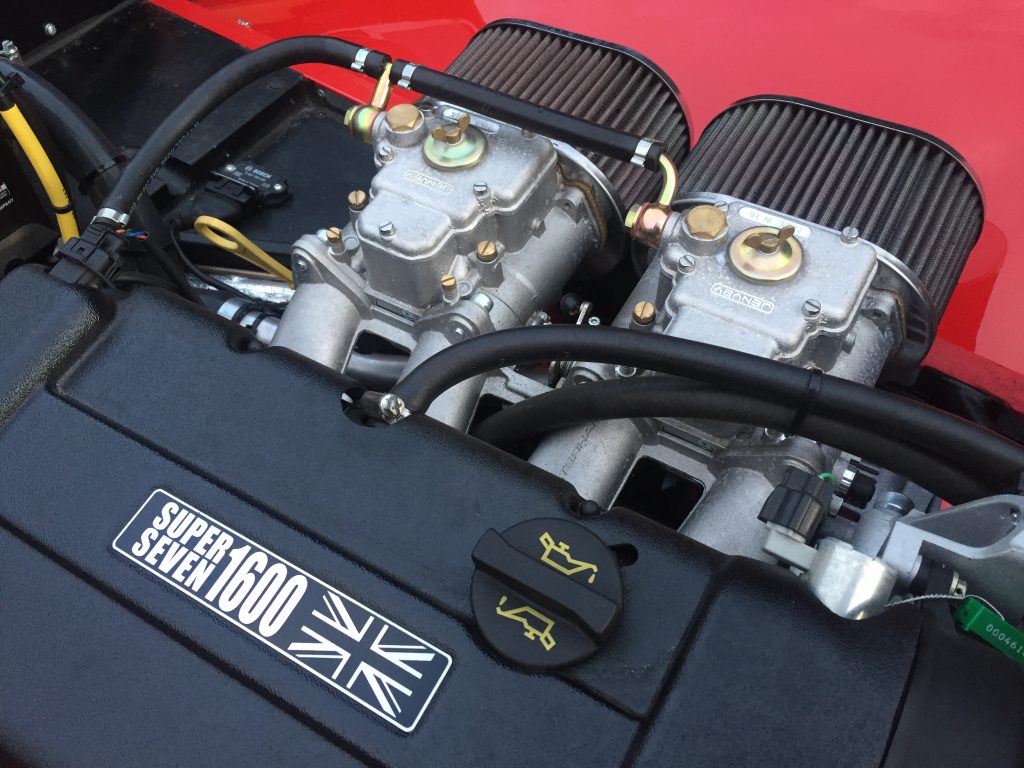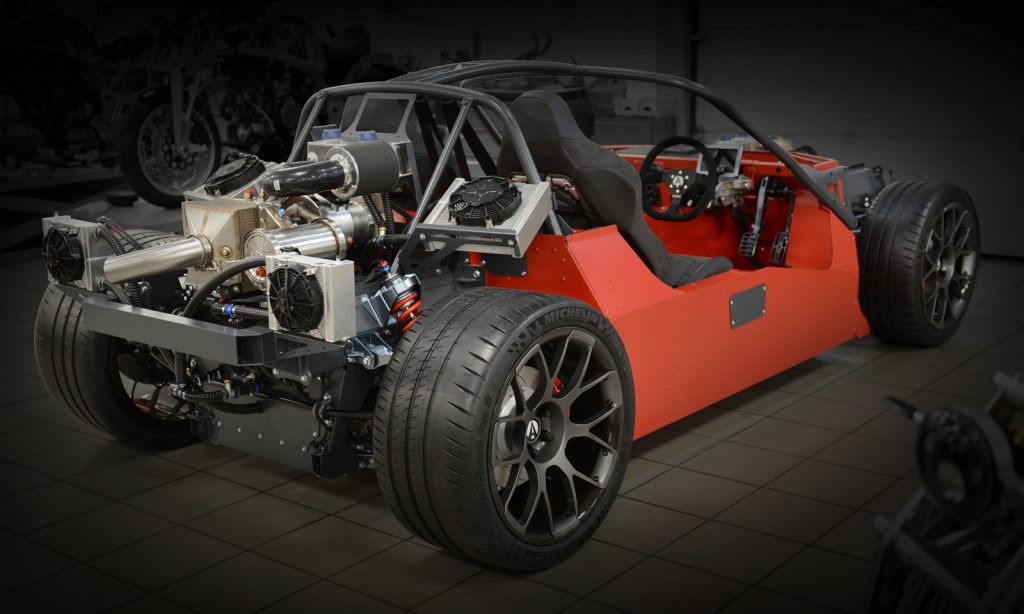So now it’s official. In almost no time at all – just nine years – all new cars sold in the UK will have to be electric, or in some cases (still to be clarified), hybrid. But where does that leave the boutique car companies of Britain, who might make a small number of cars yet have shaped a disproportionately large part of our nation’s automotive identity? Will they only be allowed to grace our roads if they sell electric cars?
The majority are niche cars made in their hundreds, rather than hundreds of thousands. Drivers in Britain – and the world beyond – adore them for their extrovert character and out-there driving experience. But the transformation to electric cars poses a number of challenges for makers of specialist cars, most notably the weight and cost of the batteries, as Graham MacDonald, CEO of Caterham, is first to point out.

“The whole ethos of the Seven is to add lightness, and the battery packs add somewhere in the region of 300kg, “MacDonald tells Hagerty, ahead of the government’s announcement of the 2030 ban on petrol and diesel-powered cars. Its range of road cars, based on the diminutive Seven – a car with roots stretching back to the Lotus Seven of the late ’50s – typically weigh between 500 and 600kg.
“It would kill the handling characteristics of the Seven,” continues MacDonald. “That’s not to say that we haven’t looked at replacing the Seven’s drivetrain with a battery pack and motors – we know the advantages of electric powertrains, and we have done some work on it. But right now, it just doesn’t fit with the Seven, and we’d also be looking at north of £100,000 (for the cost of electric cars). It’s just not a viable position at the moment.”
For all the evident issues with electrifying the Caterham Seven, MacDonald points out that developments in the mainstream will also pay off for companies like Caterham. “We don’t have the skill or budget to develop our own electric powertrain, we’re dependent on OEM [original equipment manufacturer] supplies, such as the Ford engines we use currently. With the development that’s going on, I’d like to think that we could talk with our friends at Ford, Nissan or anyone else – maybe even within the next five years. It [electric powertrains] doesn’t fit the ethos of Caterham now, but I have no doubt that it will do in the future.”
Others are taking a more proactive move towards electrification, including Ariel. Simon Saunders, founder of the reborn Ariel brand, has already shown great interest in electric vehicles including bikes and supercars, as well as the potential for an electrified version of the fabled Atom track car. Like other leaders in his field, he is aware that it would be dangerous to do nothing.
Photos: Ariel
“We are involved in several multi-million pound projects working on EVs, battery packs and control systems,” explains Saunders, a former car designer turned entrepreneur. “The Hipercar is a £20m project to develop an ultra high-performance, range-extended sports car with Ariel as lead partner. It’s accompanied by technology companies developing high performance motors, lightweight battery packs and a turbine range extender. This is accompanied by specific battery projects; part of the Farraday Challenge group of projects looking at new battery packs from efficiency improvements to end of life recycling.”
Saunders goes on to point out that low-volume manufacturers can offer benefits in technology development that larger manufacturers may struggle with. “Although we manufacture a low volume, niche product, we represent a very high demand on new systems – lowest weight, highest power and adverse range conditions such as track use. So, satisfying many of our criteria leads to a better product which can be taken up by high volume industry. As the EV industry is young and moving rapidly, many of the jumps in technology come from small technology companies like ourselves, who can adopt this technology quickly and in low numbers, start a supply chain and introduce cutting-edge technology to the market.”
Ariel is focussed on the Hipercar as its immediate electric future. Early prototypes resemble the Batmobile crossed with a Transformer. It is likely to be offered with a choice of 42 or 56kWh lithium-ion batteries, and rear- or four-wheel drive variants, and could deliver as much as 1180bhp, courtesy of the electric motors and a micro-turbine range extender. Phew.
However, while projects such as the Hipercar promise great leaps in technology as well as extravagant performance and high cost, the more attainable cars such as Ariel’s own much-loved Atom would still benefit from the technology trickling down. Saunders is confident that adapting and advancing with new technology is the only way forward.
“As many low volume manufacturers currently use high volume production engines, it is likely that as these change in line with legislation, so too will the more forward-thinking low volume producers. This may mean adopting and adapting mainstream EV or hybrid powertrains, which is considerably more complex than using an ICE, but it is a way to conform to legislation while maintaining component supply.”
Ultimately, says Saunders, “those who can’t move with requirements and legislation will die.”
While Ariel is forging forward with new technology and aims to maintain a broader range of cars including – eventually – those at the more affordable end, Lotus has chosen to focus solely on high-end electrified cars. The Norfolk-based company may be famed for Colin Chapman’s lightweight ethos but it has said publicly that it is moving away from low-volume ICE cars towards a future in high-end electrified cars, starting with the recently revealed Evija supercar.

Next on its To Do list is a super-SUV. Purists may shudder at the thought of a large 4×4 with a Lotus badge on its bonnet, but the company’s very survival is at stake.
Morgan is taking a less drastic approach to its evolution, despite having already shown the fantastically steam-punk electric Three Wheeler EV3. Steve Morris, chairman and CEO of Morgan, says the company that was once famed for refusing to change the way things were done is now focussed on an electric future.
“Models like the EV3, which is not yet planned for production,” says Morris, “have proven that there is genuine demand for an electric Morgan. The EV technology within the marketplace is evolving at such a speed, we are assessing a number of drivetrain solutions and opportunities. Of course, the starting point for any discussion about a future Morgan EV is that it should be handcrafted, lightweight, exciting to drive and available in an almost infinite combination of tailoring options. With the appropriate powertrain technology, there’s opportunity to achieve this across both a three and four-wheeled Morgan model.”
There are other factors to consider, too. Understandably, whether in private or in the open, many of these manufacturers hope that the government can be persuaded to extend the deadline or even provide an exclusion to niche manufacturers who may struggle with the economies of scale of developing electric cars.
MacDonald says Caterham is particularly hopeful about continuing with a traditional petrol-powered offering, if legislators will allow. “If we can canvass the government and say ‘look, the reality is that the cars are noisy and arguably dirty, but they get driven under 2000 miles per year – can there be an exception for low volume cars?’ And if they say yes, then great.
“We’ll continue selling the Seven as long as we can. We are already part of a number of networks – including Aston Martin and McLaren – that are already pushing for that.” He adds he can see a time where he would do his daily commute in an EV, and then indulge in a petrol-powered blast with a Seven when he feels the need to blow the cobwebs away.

Some suspect the move to electrification in the mainstream could see car enthusiasts buying more specialist models. After all, if everyday cars become more uniform, finding an outlet for motoring fun is potentially far more likely to come from a low-mileage ‘hobby’ car.
Arguably more problematic than the powertrain technology is the charging infrastructure needed to support cars. Take the challenging environment of a motor racing circuit. Can the largest venues, never mind the sort of grass-roots locations often used for track days in the UK, afford the infrastructure needed for routine super-rapid charging of multiple vehicles?
Does the answer lie in battery-swapping? It’s something Nio, one of China’s pioneering makers of electric cars, has been working at since early 2018, after it opened its first battery swap station in Shenzhen. Today, Nio has more than 131 battery swap stations are dotted around China, and has carried out half a million swaps to keep drivers on the go.
However our cherished specialist car companies are approaching the future of driving with or without the combustion engine, the good news is that every leader at the helm is optimistic about surviving and evolving with and alongside battery technology. Beyond the issues of weight and cost, all agree that the benefits of electric propulsion are clear and considerable.
As Ariel’s Simon Saunders puts it, “It’s not just a case of taking out the ICE and fitting a motor. Electrification can open up a whole new kind of performance.”

















You are not reporting on Aston Martin and Jaguar Land Rover who are producing not in the hundreds but thousands.
They aren’t niche, and sadly they aren’t British any longer.
Is it true that the Earth does not have sufficient resources of the materials necessary to manufacture the huge increase in Lithium Ion batteries which will be required by the car manufacturers & if so can we expect an alternative battery technology in just 10 years?
The switch to battery powered vehicles will do absolutely nothing to prevent climate change. It’s been well documented that a majority of the pollution regarding vehicles and for that mater any consumer products comes from their production & consequential disposal and very little if any from useage.
The condemnation of current ICE vehicles and a seemingly enforced switch to electric is purely a way of increasing car sales ( following a period of poor sales almost worldwide) and equal importance, selling finance.
I’ve noted recent comments, particularly from Green Party candidates that they would like to see a complete ban on all ICE cars by 2025. Presumably they are so blinkered as to think that their imagined replacement electric cars will not require any fossil fuels in their component production such as Lithium, Cobalt, Copper, plastic, steel, rubber and will appear by magic and at the same time the millions of current vehicles will similarly magically disappear with no pollution from their disposal whatsoever.
I also find it extraordinary that the obvious “solution” has been almost totally ignored. I refer to hydrogen power.
The hydrogen fuel cell technology could be applied to vehicles in production ten years from now whilst in the meantime a gradual conversion of existing petrol & diesel vehicles with no major mechanical changes could be implemented from almost immediate effect. Indeed I’ve studied a few classic cars at local shows over the past couple of years which have been successfully converted by their owners to run off hydrogen. All that is needed is a refuelling infrastructure along the same lines as we currently have with petrol and diesel. Why do we not persue this route which is surely far less damaging to the environment than the current craze for battery power? Come on you niche manufacturers, Morgan, Lotus, Caterham etc, press the government for a hydrogen infrastructure, develop your future cars to be powered by hydrogen and stop this slide into a ridiculous and unsustainable battery motoring nightmare.
I think all these guys are missing the option of synthetic non fossil liquid fuels sucking Co2 from the air and hydrogen from renewables =synthetic petrol. The co2 comes out of the exhaust and into the fans in the plant sucking it in so thats zero co2 see Porche fuels and Carbon Engineering Ltd.